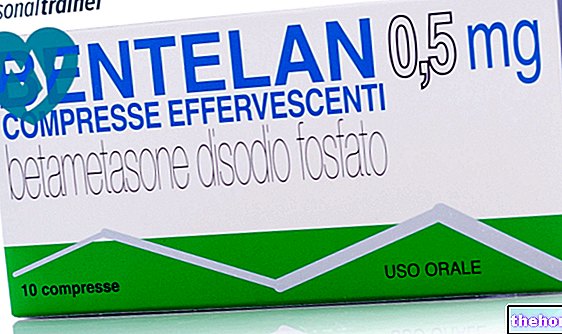Active ingredients: Levosulpiride
Levopraid 25 mg Tablets
Levopraid 25 mg / ml oral drops, solution
Levopraid 25 mg / 2 ml solution for injection
Levopraid package inserts are available for packs: - Levopraid 25 mg Tablets, Levopraid 25 mg / ml oral drops, solution, Levopraid 25 mg / 2 ml solution for injection,
- Levopraid® 50 mg Tablets, Levopraid® 50 mg / 2ml Solution for injection for i.m./e.v use.
- Levopraid® 100 mg Tablets
Indications Why is Levopraid used? What is it for?
DISPEPTIC SYNDROME (anorexia, meteorism, sense of epigastric tension, postprandial headache, heartburn, belching, diarrhea, constipation) from delayed gastric emptying linked to organic factors (diabetic gastroparesis, neoplasms, etc.) and / or functional (visceral somatizations in anxious subjects -depressants).
ESSENTIAL HEADACHE: vasomotor forms (classic, common, ophthalmic, hemiplegic, cluster migraine) and muscle-tensive forms.
VOMITING AND NAUSEA (post-operative or induced by antiblastic drugs).
VERTIGOS OF CENTRAL AND / OR PERIPHERAL ORIGIN.
Contraindications When Levopraid should not be used
Levopraid 25 mg is contraindicated in patients with pheochromocytoma because it can cause a hypertensive crisis probably due to the release of catecholamines from the tumor. Such hypertensive crises can be controlled with phentolamine. Levopraid 25 mg is contraindicated in patients with known drug hypersensitivity or intolerance. It must not be used in epilepsy, in manic states, in the manic phases of manic-depressive psychosis.
In relation to the supposed correlations between the hyperprolactinemizing effect of most psychotropic drugs and mammary dysplasias, it is advisable not to use Levopraid 25 mg in subjects who already have malignant mastopathy. Not to be used in confirmed or suspected pregnancy and during the lactation period.
Precautions for use What you need to know before taking Levopraid
Levosulpiride should not be used when the stimulation of gastrointestinal motility may be harmful, for example in the presence of gastrointestinal bleeding, mechanical obstructions or perforations. Avoid the simultaneous intake of alcohol.
Interactions Which drugs or foods can modify the effect of Levopraid
The association with psychotropic drugs requires particular caution and vigilance on the part of the physician to avoid unexpected undesirable effects of interaction. When neuroleptics are administered concomitantly with drugs that prolong QT the risk of developing cardiac arrhythmias increases.
Do not administer concomitantly with drugs that cause electrolyte disturbances.
Warnings It is important to know that:
An approximately three-fold increase in the risk of cerebrovascular events was observed in randomized clinical trials versus placebo in a population of patients with dementia treated with some atypical antipsychotics. The mechanism of this increased risk is unknown. An increased risk for other antipsychotics or other patient populations cannot be excluded.
Levopraid should be used with caution in patients with stroke risk factors. Use with caution in patients with cardiovascular disease or with a family history of QT prolongation. Avoid concomitant therapy with other neuroleptics. The effects of levosulpiride on gastrointestinal motility can be antagonized by anticholinergic, narcotic and analgesic drugs. - Effects on the ability to drive and use machines With high dosages drowsiness, drowsiness and dyskinesias may occur; patients under treatment must be warned of this so that they avoid driving vehicles and waiting for operations requiring integrity of vigilance for their possible danger.
Dose, Method and Time of Administration How to use Levopraid: Posology
Dosage in adults (according to medical prescription):
Tablets: 1 tablet 3 times a day before meals.
Oral drops: 15 drops 3 times a day before meals (one drop contains 1.6 mg of levosulpiride).
Solution for injection: 1 ampoule of 25 mg (i.m. or i.v.) 2 or 3 times a day. If patients complain of severe symptoms with nausea and vomiting and oral administration is difficult, start treatment with Levopraid 25 mg solution for injection (im or iv) 2 or 3 times a day for a few days and, when symptoms become milder, switch to oral administration for 10-15 days. If necessary, repeat the course of oral therapy for another 2 or 3 weeks, after an interruption period of at least 8-10 days. Treatment of vomiting: an i.m. vial or i.v., possibly repeated 2-3 times a day, until the symptoms disappear. If the drug is used in the prevention or treatment of antiblastic vomiting (cisplatin, anthracyclines) administer 1-2 ampoules of Levopraid 25 mg solution for injection by slow intravenous route or by infusion 30 "before the administration of the antiblastic or during the administration of the" antiblastic and repeat the same dose 30 "after the end of chemotherapy. In the treatment of elderly patients the posology must be carefully established by the doctor who will have to evaluate a possible reduction of the dosages indicated above.
Overdose What to do if you have taken an overdose of Levopraid
In internal medicine, extrapyramidal disorders and sleep disturbances have never been observed which, from a theoretical point of view, could occur with very high dosages. In this case it is sufficient to interrupt the therapy or reduce the dosage according to the judgment of the doctor.
Side Effects What are the side effects of Levopraid
For prolonged administration, some disorders such as amenorrhea, gynecomastia, galactorrhea, hyperprolactinemia and libido alterations, observed in particular cases, are attributable to a reversible effect of levosulpiride on the function of the hypothalamic-pituitary-gonadal axis, similar to that known for many neuroleptics .
The following side effects have been observed with other drugs of the same class: rare cases of QT prolongation, ventricular arrhythmias such as torsades de pointes, ventricular tachycardia, ventricular fibrillation and cardiac arrest.
Very rare cases of sudden death. It is important to inform the doctor or pharmacist of any undesirable effect, even if not described in the package leaflet.
Expiry and Retention
See the expiration date printed on the package.
The expiry date refers to the product in intact packaging, correctly stored.
Warning: do not use the medicine after the expiry date indicated on the package. Levopraid 25 mg tablets and Levopraid 25 mg / 2 ml solution for injection: no special storage precautions.
Levopraid 25 mg / ml oral drops, solution: do not freeze or refrigerate.
Use the product within 90 days of first opening the bottle, the excess product must be discarded.
Bottle with "child resistant" closure
To open Press the capsule on the bottle and at the same time unscrew normally. To close Screw the capsule back in completely.
Source Package Leaflet: AIFA (Italian Medicines Agency). Content published in January 2016. The information present may not be up-to-date.
To have access to the most up-to-date version, it is advisable to access the AIFA (Italian Medicines Agency) website. Disclaimer and useful information.
01.0 NAME OF THE MEDICINAL PRODUCT
LEVOPRAID
02.0 QUALITATIVE AND QUANTITATIVE COMPOSITION
One 25 mg tablet contains:
Active principle: Levosulpiride 25 mg
100 ml of solution contain:
Active principle: Levosulpiride 2.5 g
A 2ml vial contains:
Active principle: Levosulpiride 25 mg
03.0 PHARMACEUTICAL FORM
Tablets, oral drops solution, injectable solution for intramuscular and intravenous use.
04.0 CLINICAL INFORMATION
04.1 Therapeutic indications
DISPEPTIC SYNDROME (anorexia, meteorism, sense of epigastric tension, postprandial headache, heartburn, belching, diarrhea, constipation) from delayed gastric emptying linked to organic factors (diabetic gastroparesis, neoplasms, etc.) and / or functional (visceral somatizations in anxious subjects -depressants).
ESSENTIAL HEADACHE: vasomotor forms (classic, common, ophthalmic, hemiplegic, cluster migraine) and muscle-tensive forms.
VOMITING AND NAUSEA (post-operative or induced by antiblastic drugs).
VERTIGOS OF CENTRAL AND / OR PERIPHERAL ORIGIN.
04.2 Posology and method of administration
Dosage in adults (according to medical prescription):
Tablets: 1 tablet 3 times a day before meals.
Oral drops: 15 drops 3 times a day before meals (one drop contains 1.6 mg of levosulpiride).
Solution for injection: 1 ampoule of 25 mg (i.m. or i.v.) 2 or 3 times a day.
If patients have severe symptoms with nausea and vomiting and oral administration is difficult, initiate treatment with Levoprraid 25 mg solution for injection (im or iv) 2 or 3 times a day for a few days and, when symptoms become milder, switch to oral administration for 10-15 days. If necessary, repeat the course of oral therapy for another 2 or 3 weeks, after an interruption period of at least 8-10 days.
Treatment of vomiting: an i.m. vial or i.v., possibly repeated 2-3 times a day, until the symptoms disappear.
If the drug is used in the prevention or treatment of antiblastic vomiting (cisplatin, anthracyclines) administer 1-2 ampoules of LEVOPRAID 25 mg solution for injection by slow intravenous route or by infusion 30 "before the administration of the antiblastic or during the administration of the" antiblastic and repeat the same dose 30 "after the end of chemotherapy.
In the treatment of elderly patients the posology must be carefully established by the doctor who will have to evaluate a possible reduction of the dosages indicated above.
04.3 Contraindications
LEVOPRAID 25 mg is contraindicated in patients with pheochromocytoma because it can cause a hypertensive crisis possibly due to the release of catecholamines from the tumor. Such hypertensive crises can be controlled with phentolamine.
LEVOPRAID 25 mg is contraindicated in patients with known drug hypersensitivity or intolerance.
It must not be used in epilepsy, in manic states, in the manic phases of manic-depressive psychosis.
In relation to the supposed correlations between the hyperprolactinemizing effect of most psychotropic drugs and mammary dysplasias, it is advisable not to use LEVOPRAID 25 mg in subjects already carriers of malignant mastopathy.
04.4 Special warnings and appropriate precautions for use
An approximately three-fold increase in the risk of cerebrovascular events was observed in randomized clinical trials versus placebo in a population of patients with dementia treated with some atypical antipsychotics. The mechanism of this increased risk is unknown. An increased risk for other antipsychotics or other patient populations cannot be excluded. LEVOPRAID should be used with caution in patients with risk factors for stroke.
A potentially fatal complex of symptoms called Neuroleptic Malignant Syndrome has been reported with the use of neuroleptics (usually during antipsychotic treatment). Clinical manifestations of this syndrome are: hyperpyrexia, muscle stiffness, akinesia, vegetative disorders (irregular pulse and blood pressure, sweating, tachycardia, arrhythmias), changes in consciousness that can progress to stupor and coma.
The treatment of the S.N.M. it consists in immediately suspending the administration of antipsychotic drugs and other non-essential drugs and in instituting intensive symptomatic therapy (particular care must be taken to reduce hyperthermia and correct dehydration). If the resumption of antipsychotic treatment is deemed essential, the patient should be carefully monitored. Avoid concomitant therapy with other neuroleptics.
The effects of levosulpiride on gastrointestinal motility can be antagonized by anticholinergic, narcotic and analgesic drugs.
Levosulpiride should not be used when the stimulation of gastrointestinal motility may be harmful, for example in the presence of gastrointestinal bleeding, mechanical obstructions or perforations.
Use with caution in patients with cardiovascular disease or with a family history of QT prolongation.
Avoid the simultaneous intake of alcohol.
04.5 Interactions with other medicinal products and other forms of interaction
The association with psychotropic drugs requires particular caution and vigilance on the part of the physician to avoid unexpected undesirable effects from interaction.
When neuroleptics are administered concomitantly with QT prolonging drugs, the risk of developing cardiac arrhythmias increases.
Do not administer concomitantly with drugs that cause electrolyte disturbances.
04.6 Pregnancy and lactation
Not to be used in confirmed or suspected pregnancy and during the lactation period.
04.7 Effects on ability to drive and use machines
With high dosages, somnolence, drowsiness and dyskinesias may occur; Patients under treatment must be warned of this so that they avoid driving vehicles and waiting for operations requiring vigilance integrity due to their possible danger.
04.8 Undesirable effects
For prolonged administration, some disorders such as amenorrhea, gynecomastia, galactorrhea, hyperprolactinemia and libido alterations, observed in particular cases, are attributable to a reversible effect of levosulpiride on the function of the hypothalamic-pituitary-gonadal axis, similar to that known for many neuroleptics .
The following side effects have been observed with other drugs of the same class: rare cases of QT prolongation, ventricular arrhythmias such as torsades de pointes, ventricular tachycardia, ventricular fibrillation and cardiac arrest.
Very rare cases of sudden death.
04.9 Overdose
In internal medicine, extrapyramidal disorders and sleep disturbances have never been observed which, from a theoretical point of view, could occur with very high dosages. In this case it is sufficient to interrupt the therapy or reduce the dosage according to the judgment of the doctor.
05.0 PHARMACOLOGICAL PROPERTIES
05.1 Pharmacodynamic properties
The biochemical, pharmacological and clinical data obtained with the two isomers of sulpiride indicate that the antidopaminergic activity, both centrally and peripherally, is due to the left-handed enantiomer.
05.2 Pharmacokinetic properties
When levosulpiride is administered orally at a dose of 50 mg, the plasma peak is reached within 3 hours and averages 94.183 ng / ml. The t½ of elimination calculated after administration of 50 mg i.v. of levosulpiride is 4.305 hours.
The elimination of the drug occurs mainly via the urine.
05.3 Preclinical safety data
The acute toxicity values expressed as LD50 after oral administration in mice, rats and rabbits were respectively equal to 2450 mg / kg, 2600 mg / kg and greater than 1500 mg / kg. The values of DL 50 via i.p. in the mouse they are equal to 210 mg / kg, in the rat via i.p. and e.v. at 270 mg / kg and 53 mg / kg respectively, in rabbits via i.v. at 42 mg / Kg.
Subacute toxicity tests were conducted by administering the active ingredient daily for 12-13 weeks in rats, rabbits and dogs. No toxic symptoms were observed at doses of 25 mg / kg s.c. and 300 mg / Kg p.o. in rats, at doses of 250 mg / kg p.o. and 12.5 mg / kg i.m. in rabbits and at doses of 50 and 100 mg / kg p.o. in the dog.
Chronic toxicity tests, after administration of the drug for 180-190 days, at doses of 100 mg / kg p.o. and 20 mg / kg s.c. in the rat, of 10 mg / kg i.m. in rabbits and 20 mg / kg p.o. in dogs, they were well tolerated.
Studies performed on rats and mice, by administering the drug at a higher dosage than that expected for humans, have shown that Levosulpiride does not possess carcinogenic properties.
Studies performed on rats and rabbits have shown that the drug is not teratogenic.
In vitro tests excluded that the drug possesses mutagenic properties.
06.0 PHARMACEUTICAL INFORMATION
06.1 Excipients
• LEVOPRAID 25 mg Tablets
Carboxymethyl starch, microgranular cellulose, lactose, magnesium stearate.
• LEVOPRAID 25 mg / ml Oral drops solution
Acesulfame K, anhydrous citric acid, purified water, lemon flavor, methyl p-hydroxybenzoate, propyl p-hydroxybenzoate.
• LEVOPRAID 25 mg / 2 ml Solution for injection for i.m./e.v use.
2 N sulfuric acid, water for injections, sodium chloride.
06.2 Incompatibility
No data are known in this regard.
06.3 Period of validity
5 years
06.4 Special precautions for storage
No special storage precautions.
LEVOPRAID 25 mg / ml Oral drops solution. Use the product within 90 days of first opening the bottle, the excess product must be discarded.
06.5 Nature of the immediate packaging and contents of the package
- Carton containing 20 tablets of 25 mg in blister (aluminum / PVC / PVDC)
- Carton containing a glass dropper bottle, with "child resistant" closure, containing 20 ml of solution
- Box containing 6 ampoules of 25 mg / 2 ml
06.6 Instructions for use and handling
LEVOPRAID 25 mg / ml Oral drops solution
Bottle with "child resistant" closure
To open
Press the capsule onto the bottle and at the same time unscrew normally.
To close
Screw the capsule back in completely.
07.0 MARKETING AUTHORIZATION HOLDER
TEOFARMA S.r.l. - Via F.lli Cervi, 8 - 27010 Valle Salimbene (PV)
08.0 MARKETING AUTHORIZATION NUMBER
"25 mg tablets" 20 tablets - A.I.C .: n. 026009011
"25 mg / ml oral drops solution" dropper bottle of 20 ml - A.I.C .: n. 026009035
"25 mg / 2 ml solution for injection" 6 ampoules of 2 ml - A.I.C .: n. 026009023
09.0 DATE OF FIRST AUTHORIZATION OR RENEWAL OF THE AUTHORIZATION
First authorization: 20.11.1985
Authorization renewal: 01.06.2010
10.0 DATE OF REVISION OF THE TEXT
February 2012























-nelle-carni-di-maiale.jpg)




